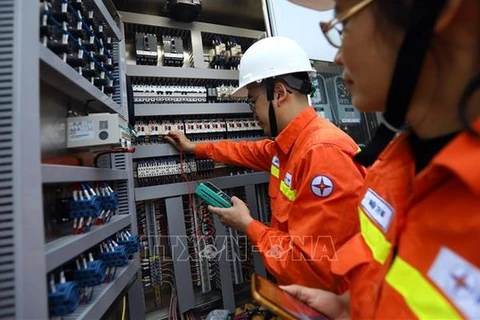 The plan strives to increase the share of renewable energy in the country's power mix to between 67.5-71.5 % by 2050. (Photo: VNA)
The plan strives to increase the share of renewable energy in the country's power mix to between 67.5-71.5 % by 2050. (Photo: VNA) Hanoi (VNA) - The National Power Development Plan VIII, which has been recently approved by the Prime Minister, aims to ensure national energy security, thus satisfying the country's socio-economic requirements in the time ahead.
The plan, which guides the development of power plants and power grids between 2021 and 2030, with a vision until 2050, outlines a comprehensive strategy to develop power sources and transmission grids with voltages of 220kV or higher, with a special focus on renewable and new energy sectors within the territory of Vietnam.
The plan’s objective is to maintain Vietnam's energy security by ensuring a sufficient supply of electricity to fuel a projected annual GDP growth rate of about 7.0% during the 2021-2030 period, and 6.5-7.5% in 2031-2050.
It also aims to bring Vietnam into the top four countries in ASEAN in terms of power reliability. Additionally, half of the office buildings and homes in the country would be powered by rooftop solar panels by 2030.
Regarding the just energy transition, the plan strives to increase the share of renewable energy in the country's power mix to between 67.5-71.5 % by 2050.
Greenhouse gas emissions from energy production would be cut to around 27-31 million tonnes by 2050 from about 204-254 million tonnes in 2030.
If international partners fully implement the Just Energy Transition Partnership (JETP) commitments, the country will be able to reduce gas emissions to less than 170 million tonnes by 2030.
Two inter-regional energy hubs would be established by 2030, which will see power plants, power grids, and facilities that manufacture energy-related equipment. The hubs would be located in certain well-positioned regions, including the northern, south central and southern regions.
In addition, it sets a goal to increase electricity export capacity, aiming to reach approximately 5,000-10,000 MW by 2030.
[National Power Development Plan VIII – breakthrough in energy sector]
The plan needs 134.7 billion USD in funding to develop new power plants and power grids between 2021 and 2030. The figures would soar to between 399.2 - 523.1 billion USD by 2050, with a large part of which is allocated for new power plants and less than 40 billion USD for power grids.
The Government has issued Decision No. 500 to legislate the PM's approval of the plan. Under the Decision, the implementation of the plan would be put under the authority of the Ministry of Industry and Trade.
The ministry is also tasked with preparing the draft versions of the Revised Law on Electricity and Law on Renewable Energy, which must be summited to the National Assembly for discussion in 2024.
The decision also stipulates that the ministry provide governmental policy advice on direct power purchases and accelerate those energy projects that have been hindered by complications.
It is worth noting that the State is advocating for a plural power sector based on fair competition and a market electricity price, which would ensure a level playing field for all investors.
The approval of the plan reflects the consistent viewpoint that electricity is part of important infrastructures, and the development of the power sector must take a step ahead to create a foundation for rapid, sustainable national development.
Power development must closely follow the global technological trend, especially in renewable energy, and go in tandem with the transition towards a green, circular, and low-carbon economy. Energy transition must match international trends and ensure sustainability, fairness, and justice./.

























